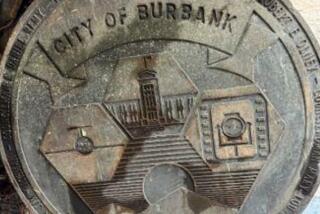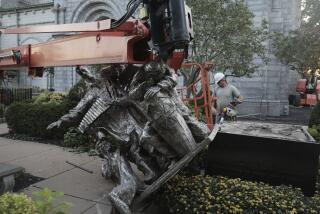Thieves who took bronze had brass
The green patina gave the bronze statue of a gold miner a sense of antiquity, speaking to its 80 years of service in a small park in Mid-City Los Angeles.
And then last week, a 22-month-old boy on his way home from day care noticed something awry in his daily routine. “No, no, no,” he said from the back seat. His mother, Clara Magyar, turned to look.
The 7-foot miner was gone.
When neighbors in the Carthay Circle community heard the news, they feared it had been stolen for scrap, like so much copper wire and plumbing around the region, as prices for metal have soared.
“I think someone stole him to have him melted down,” said Judy Moore, president of the Carthay Circle Neighborhood Assn. “I don’t want to see him as rain gutters. It just breaks my heart. He was part of neighborhood history.”
Los Angeles police are investigating the theft and others, and they suspect the miner was indeed taken for scrap. Nationwide, bronze, brass and copper artworks are vanishing into scrap yards, destined for the foundry furnace.
The theft of public art -- as well as the stripping of homes and streetlights of copper wire and plumbing -- can be bold. Late last month in Brea, thieves used a cutting torch to remove a 6-foot-tall, 4-foot-wide bronze sculpture from its concrete stand in front of a business. The work, “Faceless Crowd,” had been featured on a tour of the city’s public art. It was the third theft of a statue in Brea in nine months, where fire hydrants, commercial plumbing fittings and trucks’ catalytic converters have also gone missing.
“This has been going on for as long as metal existed,” said Brea police Lt. Jack Conklin. “But only recently has the price of metal gone through the roof.”
So far, Brea police have been unable to track down the missing statues. Detectives say the thieves typically cut up the artworks and take different bits to different scrap yards to avoid suspicion.
Los Angeles police detectives say they won’t comment on their investigations.
Many thieves in Los Angeles are targeting the wiring used for street lighting. In December, police announced that 370,000 feet of copper wire had been stolen in four months, disabling 700 street lights. The thieves open boxes at the bases of adjacent poles, snip the wire that runs between them and pull it out one end. Police say they often they work in industrial areas at night.
The theft of the gold miner statue required more audacity.
The miner stood in plain view, perched on a boulder and holding his gold pan, at the busy intersection of San Vicente and Crescent Heights boulevards.
He was something of a character in Carthay Circle, a quaint neighborhood of big ash trees and Spanish and Tudor revival homes. Not too much is known about the statue, but it was sculpted by Henry Lion in 1924 and 1925, along with a fountain, and commemorated 19th century settlers in California.
Authorities across the country say turning sculpture into scrap squanders it, like turning diamonds into coal.
An artist in Sedona, Ariz., had seven bronze figures stolen from his ranch last year. He estimated the pieces were worth $1 million as art -- and $20,000 as two tons of metal.
Last month, at the Lewis and Clark National Historical Park near Astoria, Ore., a thief stole a 5 1/2 -foot bronze statue of Sacagawea and her baby, valued at $20,000. Police arrested a man and tracked down parts of the statue -- sold for scrap for $250.
“These guys are getting a penny on the dollar,” said Tom Bergin, sheriff of Clatsop County, Ore. “It’s just ludicrous.”
Bergin said much of the theft in his area is driven by methamphetamine and heroin addicts desperate for money for a quick fix. “They’re taking anything from bleachers to guardrails,” he said.
Scrap yards are paying more than $3 a pound for copper and more than $2 a pound for bronze and brass, both of which are alloys containing copper.
Law enforcement agencies are trying to work with scrap yards to spot stolen metal.
DBW Metals Recycling in Anaheim has helped police arrest at least 18 people in the last year trying to sell metal of dubious origin, said general manager Stewart Shirk.
When he spots a suspicious person trying to sell a catalytic converter or back-flow valve -- a piece of commercial plumbing frequently stolen -- he tries to stall them and calls authorities.
Shirk says most of the stolen copper, bronze and brass gets shipped to China or India, where it is melted down, mixed with cheaper metals and refabricated. He said that much of the material is ultimately shipped back to the United States as the same type of fittings and valves that were stolen in the first place -- but poorer in quality.
“I’ve seen these valves brand-spankin’ new from China, and they’re defective,” he said.
In Carthay Circle, the missing statue “was just part of the history of the whole neighborhood,” Moore said. “It’s kind of like an old faithful dog. You just take it for granted that he’ll be there.”
She said she had feared the historic statue would get stolen. “But then it’s so heavy and it’s such a busy intersection, I thought, ‘Well, maybe he’s safe.’ ”
She estimates that the statue weighed up to 1,000 pounds.
Moore walked right by the park Saturday and somehow didn’t notice it was missing. A giant pine tree shades the spot, and some bus benches obscure it from certain angles.
And then Monday she received an e-mail from neighbor Jon Armstrong, father of the toddler who noticed its absence. The Armstrong family anointed the statue “Pizzaman” -- because of the pan.
“I was wondering whether you know what has happened to the statue,” Armstrong wrote.
Moore’s heart sank. She walked to the park to see for herself. All that was left was the stump of a bolt that had held the miner to his boulder. She crossed the street to see if a bronze bust that Lion had also sculpted was still in its place. It was, but she learned that, a week before, the night watchman for surrounding businesses had scared away someone who appeared to be tampering with it.
Moore sent out an e-mail to the rest of the neighborhood association.
“I’d hate to see this statue melted down and some crook paid a few hundred dollars for the metal,” she wrote. “It’s been part of the neighborhood for over 80 years! We need to find our gold miner!”
--
--
Times staff writer Andrew Blankstein contributed to this report.
More to Read
Sign up for Essential California
The most important California stories and recommendations in your inbox every morning.
You may occasionally receive promotional content from the Los Angeles Times.











